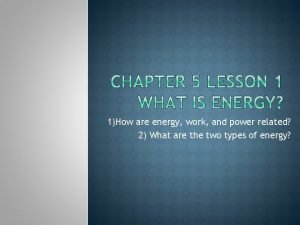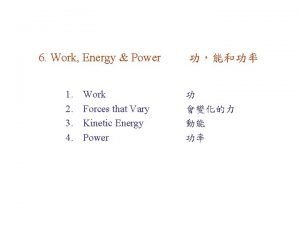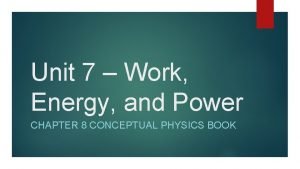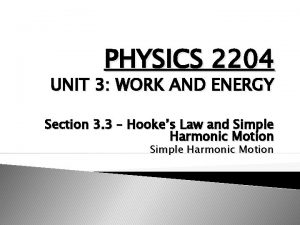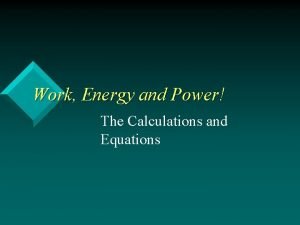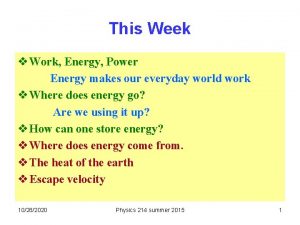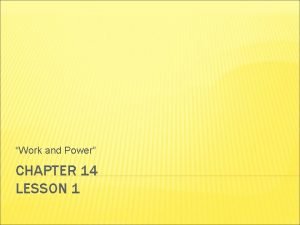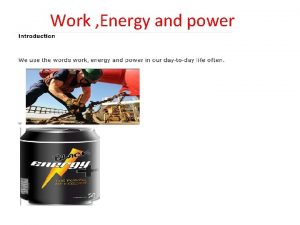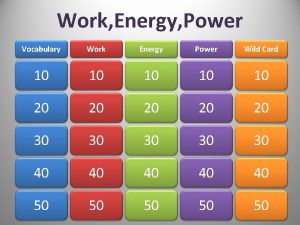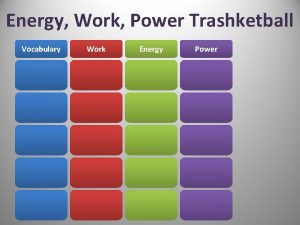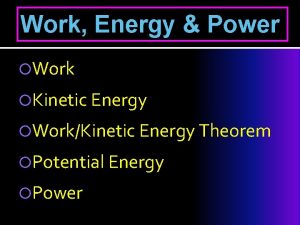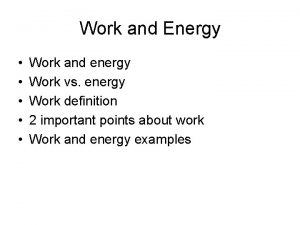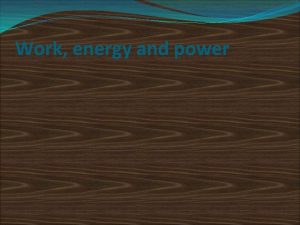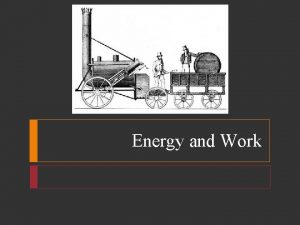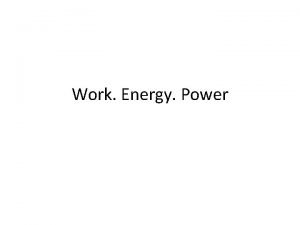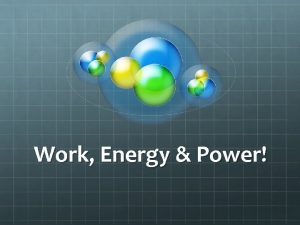WORK ENERGY POWER Types and changes of Energy


































- Slides: 34

WORK, ENERGY, POWER

Types (and changes) of Energy

Types (and changes) of Energy

Types (and changes) of Energy

Types (and changes) of Energy

Types (and changes) of Energy

Types (and changes) of Energy

Types (and changes) of Energy

Types (and changes) of Energy

Types (and changes) of Energy

Types (and changes) of Energy

How does energy change take place? • An outside force is needed!

4 ways to approach a mechanics problem 1) Kinematics 2) Newton’s 3 Laws 3) Energy 4) Momentum

If released from rest, car would accelerate Can’t use kinematics because the track is curved Acceleration changes, so kinematics equations are not valid Must use energy concepts instead

Energy • • Energy: The ability to do work Energy is a scalar value Measured in Joules A joule is a Nm or kg m 2/s 2

Kinetic Energy • Energy of Motion • Translational Kinetic energy exists when an object’s center of mass is moving • K = ½ mv 2 • Rotational Kinetic energy exists when an object rotates (more about this in another unit)

Potential Energy • Stored energy • Gravitational Potential Energy is energy stored due to an object’s height • Ug = mgΔh • Elastic Potential Energy is energy stored by a spring • Us = ½ kx 2 • k is the spring constant, x is distance stretched

More Vocab • Mechanical Energy: Sum of kinetic and potential energy

Work • Its units are Joules • That’s the same as energy!! • (That’s because energy is the ability to do work!)

Work • Can be defined as – A change in energy W = ΔE – OR – The product of force and distance W = Fd

Power • Whether you walk up a mountain or drive up it, the same amount of work is done on you. You weigh a certain number of newtons and you move a certain distance. But clearly there is a difference in walking up over the course of several hours and driving up over several minutes. That difference is power! Power = energy/time • Rate of doing work • Units are Watts. A watt is a Joule/sec • P = W/t = ΔE/t

Example • A 10 kg pumpkin is moved horizontally 5 m at a constant velocity across a level floor using a horizontal force of 3 N. How much work is done in moving the pumpkin? • Note: Use applied force, not net force

Example A 3 kg pineapple is held 1. 2 m above the floor for 15 s. How much work is done on the pineapple? Note: No distance means no work

Example A 50 kg banana box is pulled 11 m along a level surface by a rope that makes an angle of 35 o with the floor. The tension in the rope is 90 N. How much work is done on the box? • Note: Use the component of the force that is in the direction of displacement

Example • A 1385 kg car traveling at 16. 9 m/s is brought to a stop while skidding 42 m. What is the work done on the car by friction? • Note: Work can be negative if the force doing the work acts in a negative direction

Example • A 60 kg student is running at a uniform speed of 5. 7 m/s. What is the kinetic energy of the student?

Example • The kinetic energy of 2. 1 kg rotten tomato is 1000 J. How fast is it moving?

Example A 15 kg textbook is sitting on a 1. 2 m tall table. If the book is lifted 0. 8 m above the table, how much gravitational potential energy does it have: a) with respect to the table? • b) with respect to the floor? • Note: Ug is always measured relative to a reference point

Example An archer pulls on a bow string with an average force of 240 N while drawing the arrow back a distance of 0. 2 m. Calculate the potential energy of the bow-arrow system.

Example An experiment was conducted on a 1. 1 kg cart. The force to pull it up a. 26 m ramp and the height of the ramp were measured for 3 trials and the data is shown here. Calculate the work done and the Ug at the top of the ramp for each trial. Trial 1 Trial 2 Trial 3 Force 3. 3 N 5. 0 N 6. 2 N Height 0. 08 m 0. 12 m 0. 15 m How does the work done on the cart compare to its gain in potential energy?

Example It takes 1000 J of work to compress a spring 0. 1 m. What is the spring constant? To compress the spring an additional 0. 1 m, does it take 1000 J, more than 1000 J, or less than 1000 J. Verify your answer.

Example • A spring with force constant 250 N/m is initially at its equilibrium length. How much work must you do to stretch the spring 0. 05 m?

Example • Lover’s Leap is a 122 m vertical climb. The record time of 4 min 25 s was achieved by Dan Osman (65 kg). What was his average power output during the climb?

Example • A 1000 kg car accelerates from rest to a velocity of 15 m/s in 4 s. Calculate the power output of the car. Ignore friction.
 Changes in latitudes, changes in attitudes meaning
Changes in latitudes, changes in attitudes meaning Physical and chemical changes
Physical and chemical changes Chapter 4 work and energy section 1 work and machines
Chapter 4 work and energy section 1 work and machines Power trianlge
Power trianlge Work, power and energy activities
Work, power and energy activities Work definition physics
Work definition physics How are energy work and power related
How are energy work and power related Work power energy and machines
Work power energy and machines Definition of work power and energy
Definition of work power and energy Work power and energy
Work power and energy Unit 7 work energy and power answers
Unit 7 work energy and power answers Work energy theorem
Work energy theorem 0kei0
0kei0 Work and energy
Work and energy Physics 2204 unit 3: work, power, energy
Physics 2204 unit 3: work, power, energy Work energy power equations
Work energy power equations F= ma units
F= ma units Work and energy section 2 describing energy answer key
Work and energy section 2 describing energy answer key Types of software changes
Types of software changes Types of software changes
Types of software changes Two types of changes in matter
Two types of changes in matter Adaptive maintenance in software engineering
Adaptive maintenance in software engineering Energy energy transfer and general energy analysis
Energy energy transfer and general energy analysis Energy energy transfer and general energy analysis
Energy energy transfer and general energy analysis Calculation of enthalpy
Calculation of enthalpy Energy changing form
Energy changing form Energy changes
Energy changes Energy changes
Energy changes Solar power satellites and microwave power transmission
Solar power satellites and microwave power transmission Potential power
Potential power The dispersive power of grating is
The dispersive power of grating is Work power and efficiency
Work power and efficiency Define work and power
Define work and power Unit 14 lesson 1 drivers ed
Unit 14 lesson 1 drivers ed Definition of work physics
Definition of work physics






